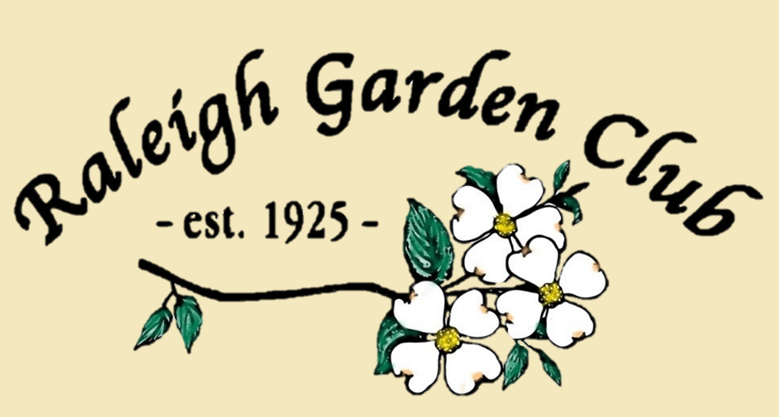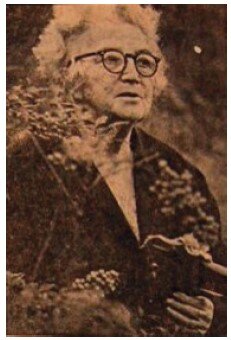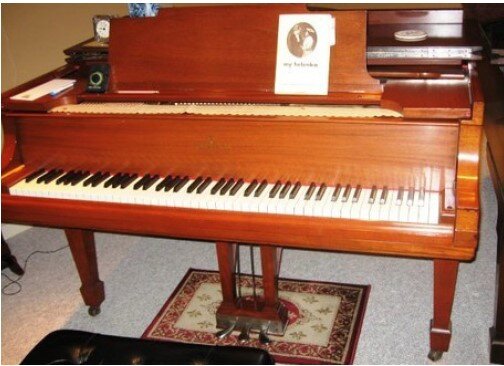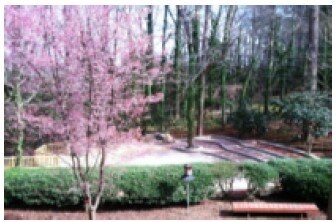by Vicki Sanders Corporon
Mary Lee Swann McMillan (1890-1981)
One of Raleigh Garden Club’s most memorable presidents made a significant impact in many areas of public service during her long life of nine decades.
She came to be known as The Camellia Lady, but there’s so much more to her story.
EARLY INFLUENCES
She was born in Kingstree, South Carolina to Mary Frances (Lewis) and James Milan Swann. Following her early education, she attended Winthrop Normal and Industrial College of South Carolina, Rock Hill (which later became Winthrop College and still later Winthrop University) and earned a Commercial Department certificate there in 1913.
She moved to New York to enroll at Teachers College of Columbia University. She also attended the New York School of Fine and Applied Art (that we now know as Parsons School of Design, it was founded in 1896 and is still recognized today as a top design school).
CAREER MILESTONES
In 1915 she was asked to chair the Home Economics Department of Bernard School of Household Arts in New York City. She also taught at the Scudder
School of Household Arts. In addition to these teaching assignments, she wrote a weekly homemaking column for American Weekly.
The next three years she served as the personal secretary to Madame Helena Paderewski, the wife of Ignacy Jan Paderewski, an internationally-renowned pianist and Polish patriot. Inspired by that couple, Mary Lee worked with the Polish Victim’s Relief Fund and helped organize the Polish White Cross.
Decades later Mary Lee McMillan would reflect on the impressive accomplishments and impact Madame Paderewski had on her. Distilling those memories coalesced into a full-length biography she co-wrote with Ruth Dorval Jones in 1972. They affectionately titled the book, My Helenka.
LIFE IN RALEIGH In 1918 Mary Lee Swann met Robert Leroy McMillan, a native of Scotland County, NC. He too was studying in New York City. Once he received his law degree from Columbia University, he was admitted to the North Carolina bar in 1919. They married and the young couple moved to Raleigh, where they made their home and impacted the community via their talent and service.
To thank Mary Lee for helping Helena Paderewski with the Polish Relief efforts and add a lifetime treasure to their new home, in 1924 Ignacy gifted one of his Steinway pianos to Mary Lee. His signature is inscribed inside the piano sent to her in Raleigh. Helena sent Mary Lee this note:
My dear Maria,
Nuncio has autographed the Steinway which we are sending to you. He has selected it for its tone. You remember that he has autographed one other piano and that was for our friend Alma Tadema, the great English artist. This piano, my dear child, will remind you of the days we were together and my husband is sending it with happiness.
Note sent by Helena Paderewski to Mary Lee McMillan May 10, 1024 Regarding shipment to Raleigh of the Steinway, Model M, 224070
The couple had two sons: Archibald Alexander and Robert LeRoy, Jr. They not only grew up in the prestigious Cameron Park area of downtown Raleigh, with a beautiful, well-tended garden surrounding their home, but within their home they had a world-famous piano for personal enrichment and performances by distinguished visitor guests.
In 1966, Mrs. McMillan was named North Carolina’s Mother of the Year! Besides parenting abilities that might have contributed to being nominated for that award, the committee no doubt considered candidates’ wide range of social and civic contributions. Mary Lee’s record of service to the community sets a high bar for us all.
CLUB AFFILIATIONS
Mary Lee filled her “spare” time with an incredible diversity of volunteer involvements. She and her husband were active members of the Pullen Memorial Baptist Church. To this day, the church has a Circle named for Mary Lee McMillan to honor her dedication to that congregation.
She was also a member of the Woman’s Club of Raleigh and served as their president from 1945-1947. In addition, she was a supporter of the March of Dimes, the Clan McMillan Society, the American Legion Auxiliary (Raleigh Unit), the Olla Podrida Book Club, the NC Office of Civilian Defense, the State Recreation Commission, the Johnston Pettigrew Chapter of the United Daughters of the Confederacy, the Daughters of the American Revolution, and the Parent-Teachers Association. But that’s not all!
GARDENING
For gardening enrichment and outreach, she joined the Raleigh Garden Club in 1929 and served as our president from 1934-1936. Over the years she built strong ties at the state level via the Garden Club of North Carolina, the National Council of State Garden Clubs, and the NC Camellia Society.
She filled her own garden with a wide variety of camellias, and the blooms from these plants provided the inspiration for making corsages and delivering these to hospital and nursing home patients. Word has it she created from 800 to 1,000 pillow corsages each year for this uplifting gift of beauty to those folks facing challenging health concerns. She did this for 40 years! Now you can see why they affectionately called her The Camellia Lady.
From its initial organization in 1949, Mary Lee McMillan was not only welcomed into the new Raleigh Camellia Society, but she was also made an honorary life president. Within the NC archives, we have the registration book for the group’s 1950 Camellia Day event and yearbooks and minutes attesting to the influence Mary Lee had on that organization and on popularizing the use of camellias into local landscapes. Mary Lee’s personal garden is included in Old Homes and Gardens of North Carolina, with this descriptor:
The “Camellia Lady” is probably the most generous flower grower in the Club. Almost daily a tray of nosegays, single camellias, roses or whatever is in season, or a dried arrangement of red and green pepper pods, acorns or small cones, or a nylon flower gets to the sick in hospitals; if a friend is having a party, it’s almost a certainty a “Mary Lee Arrangement” will be there too. The at-home sick are remembered too.
Mary Lee made a significant impact on the Woman’s Club of Raleigh, first joining the club in 1920. In the late 1960s, the Woman’s Club of Raleigh (WCR) looked for land to develop and build a clubhouse. They purchased six acres, built the clubhouse and created an access road via Glenwood Avenue, aptly named Woman’s Club Drive. From 1946 until the late 60s, the Woman’s Club and Raleigh Garden Club had both been meeting at a clubhouse on Hillsborough Street. With the new WCR clubhouse constructed, the Raleigh Garden Club aided their sister group by installing a garden at the new site. This new garden was officially dedicated in 1973.
Since Mary Lee served as WCR president from 1945-1947, a cherry tree was planted in Mrs. McMillan’s honor in the new garden, and when this bloomed, the Raleigh Times newspaper wrote a feature story describing the lovely Mary Lee McMillan Garden adjacent to the Woman’s Club of Raleigh.
The garden included many of Mary Lee’s favorite perennial plants (like azaleas, rhododendrons and camellias) as well as flowering trees (like cherry and crepe myrtle), massive boulders, and several redwood benches to take in the vistas. Speakers at the 1973 garden dedication included Pulitzer prize-winning Paul Green, William Lanier Hunt (founder of the NC Botanical Garden), Clarence Steppe of Wayside Nurseries, Wayne McBride of Lewis Clarke ssociates who designed the garden, and Herbert O’Keef of the Raleigh Times. The Rev. W.W. Finlator gave the dedicatory address. Needless to say, this event was the place to be in town that day!
Approximately 50 years later, the WCR folks and the Irregardless Café benefactors Arthur and Anya Gordon allocated funds to give the garden a facelift, and that has been accomplished.
RALEIGH GARDEN CLUB +
Her impact on our Raleigh Garden Club bloomed in multiple ways. First, she impacted the group as an active community volunteer and personal gardener. She joined the club in 1929 and actively participated in their events until 1977! She first established her credentials by maintaining an exemplary home garden. When asked to step up and serve as the club’s president from 1934-36, she looked beyond our city’s wealth of distinguished garden experts and invited nationally-known dignitaries to the Raleigh Garden Club — she hosted speakers from as far away as New York to talk to the group on floral design. She inaugurated the first Garden School in the country — a three-day course of study that was a big success! And she popularized gardening through her regular columns in the Raleigh Times for 25 years.
Mary Lee and the RGC Broadcasting Committee pioneered a gardening talk show on the radio in the early 30s, entitled Garden School of the Air; in 1939 it was renamed Garden Club School of the Air — the forerunners of The Weekend Gardener that is still on air today, on WPTF. She also impacted the Raleigh Garden Club as a featured speaker. In one talk, she memorably introduced club members to the International Peace Garden, a 3.65 square-mile park located on the North Dakota border with Manitoba, Canada. It was her hope that women everywhere could do much to prevent future wars by filling the minds of students and adults with thoughts of beauty, peace and orderliness — above all, with a love of art. Since both her sons fought with the Marines in WWII, she surely had to wish hher philosophy had had more impact on world affairs, but at least her sons survived their wartime engagements and had successful careers. Son Robert Leroy McMillan joined his dad’s law firm.
After serving as Raleigh Garden Club president, Mary Lee moved on up in the gardening world of North Carolina. In 1947, she was elected president of the Garden Club of NC (the affiliation of all the local garden clubs across the state). During her term in office, she revitalized the statewide club. She broadened the scope of action and coordinated the efforts among the regional clubs. She spoke to the Lumberton Garden Club as the honored guest in 1947. She promoted the NC Roadside Council and later served as Finance Chairman and Chairman of the Tryon Palace Garden Committee. Not surprisingly, she was offered several national offices, but here in NC in 1957 we honored her one more time with the Maslin Award, the highest honor for lifetime achievement by a member of the Garden Club of NC.
ARCHIVAL RECORDS
The McMillan Papers (PC.1677) are archived in our state files. These include circular letters, reports, publications, newspaper and magazine clippings, photographs and more from 1908 to 1980, representing the literary, political and social activities of Robert L and Mary Lee McMillan. The files also include parts of a four-act play entitled Japonica, written by Robert and Mary Lee McMillan — their only husband-wife writing project.
Another item archived is a 1964 program showing that Mary Lee McMillan’s remarkable life was the focus of the John Charles McNeill Book Club meeting!
LASTING LEGACY
Mary Lee McMillan was referred to as the “Pied Piper of Cameron Park” because children in the neighborhood would gather and play in her yard. Once when the circus came to town, she invited the neighbors’ kids for a breakfast at her home and hosted a clown to entertain them. The local kids had to dearly love this Pied Piper!
Raleigh Garden Club’s “Camellia Lady” died October 7, 1981 at the age of 90 after an incredibly productive and generous life. She was buried beside her husband in Wagram Cemetery, Scotland County, North Carolina.
Mary Lee Swann McMillan’s legacy lives on through her writings, her garden at the Woman’s Club of Raleigh beloved for weddings, and through her inspiring example as a devoted gardener who shared the bounty joyfully!







